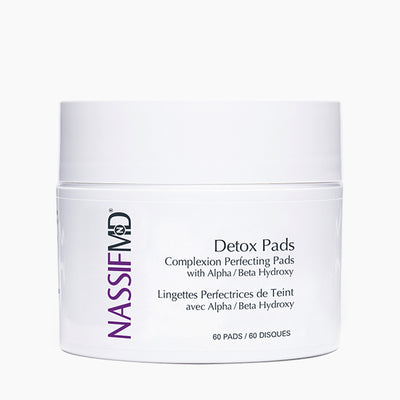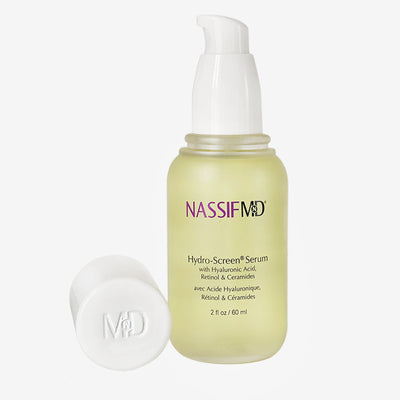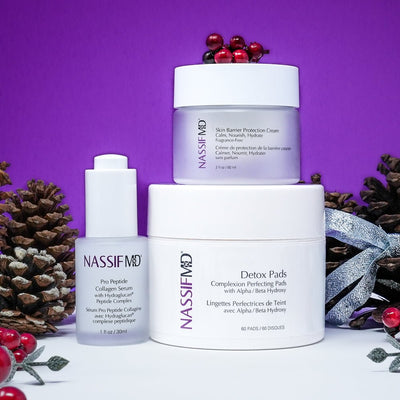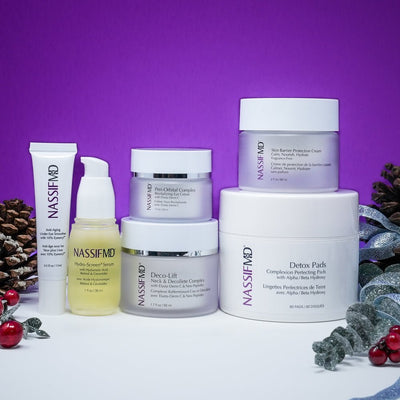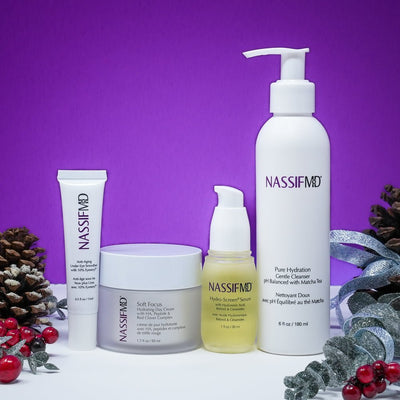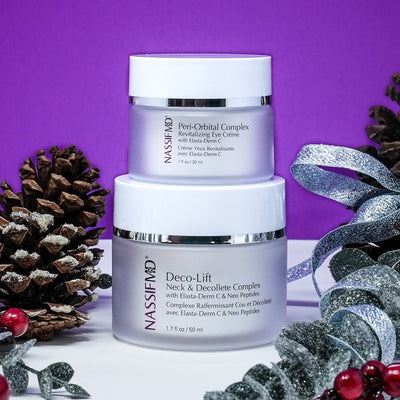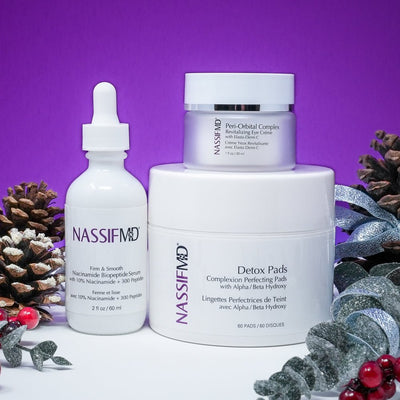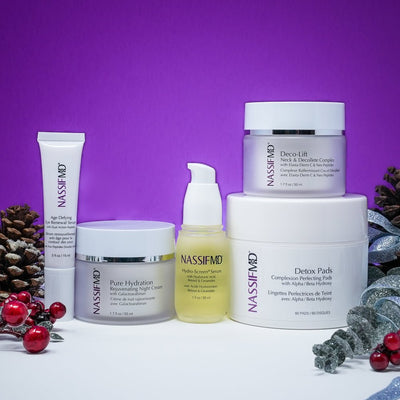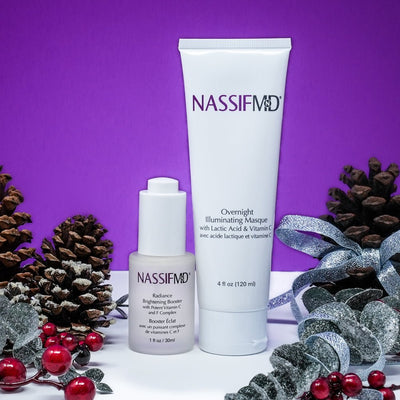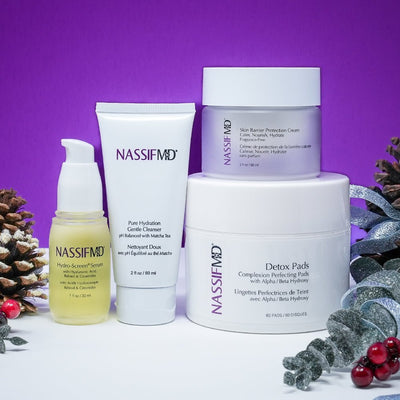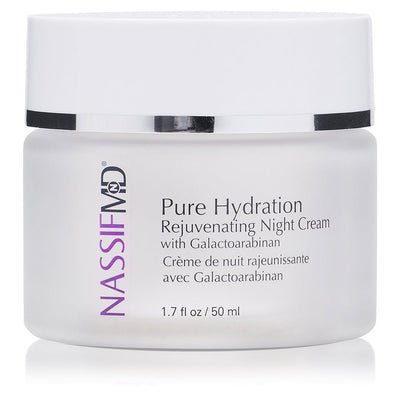How to Moisturize While Using Retinol
Retinol is a powerful skincare ingredient that can transform multiple skin concerns, yet it can be harsh and drying, especially when you first start using it. However, making it through the first few weeks of use will unlock the anti-aging benefits and hydrated, youthful skin.
Using retinol along with a moisturizer is a helpful strategy for minimizing retinol’s side effects. Many people ask if it’s better to use retinol before or after moisturizer. And today’s article will dive into this question. Spoiler: it might depend on your skin type.
Keep reading to learn more about:
- What is retinol?
- Retinol benefits
- Do you use moisturizer or retinol first?
- How long after retinol to apply moisturizer
- Side effects of retinol use
- What moisturizer to use with retinol
- The best NassifMD® retinol serums, utilizing a synergy of active ingredients
How Do You Moisturize While Using Retinol?
Before we dive into the details of your moisturizing routine, let’s ask what does retinol do? Retinol is an active form of vitamin A that visibly improves the skin’s appearance. Retinol has many benefits and actions, including:
- Minimizing fine lines
- Reducing wrinkles
- Decreasing hyperpigmentation
- Brightening the skin tone
- Evening the skin texture
- Improving barrier function
- Speeding up cellular turnover
- Regulating oil production
- Promoting collagen production (and inhibiting collagen loss) for better skin structure
For youthful, glowing skin, retinol tops the charts for skincare ingredients. Still, it can take a few weeks for your skin to adjust to retinol, a process called retinization, during which you may experience skin redness, dryness, and irritation. Adding a moisturizer can help.
Applying Retinol Serum or Retinol Cream with Dry Skin
Whether you use moisturizer before or after retinol may have to do with your skin type. This skincare question doesn’t have one right answer; you may need to experiment a little to find what works best for your skin.
Combining retinol with other active ingredients, like hyaluronic acid, niacinamide, ceramides, and natural oils, can enhance retinol function and support a healthy skin barrier that minimizes retinol side effects. Look for these active ingredients in your moisturizer and in your retinol cream or retinol serum.
Barrier support is particularly beneficial for those with dry or sensitive skin.
Moisturize Before Retinol Application
Use a thin layer of moisturizer before applying retinol serum if you have dry or sensitive skin. Using moisturizer before retinol is also a good rule if you are new to retinol and unsure how your skin will respond. You can also start slowly using a retinol product once or twice a week. Then, gradually increase for additional benefit.
If you notice retinol side effects immediately, add another layer or moisturizer over it too.
Applying Retinol Serum or Retinol Cream with Normal to Oily Skin
Normal skin tends to be neither dry nor oily, while oily skin is characterized by excess oil (sebum) production. Both skin types benefit from the anti-aging effects of retinol and may tolerate retinol serums better than dry or sensitive skin. Additionally, normal or oily skin may adjust to retinol more quickly when you are new to retinol.
Moisturize After Retinol Application
Can I put moisturizer over retinol? Yes! If your skin is normal, or oily, or you are used to using retinol products already, use moisturizer after retinol serum. Applying a layer of moisturizer over the retinol helps the retinol penetrate more deeply and seals it in.
How Long Should You Wait Between Skincare Steps?
Following your personal skincare routine add retinol serum to damp skin (or moisturize first then follow with retinol serum for dry or sensitive skin). Then, wait a few minutes for it all to soak in.
After a few minutes, you can apply SPF moisturizer during the day. Follow with a nighttime moisturizer during your evening skincare routine.
If you are starting out with retinol, use it at night. Then, use SPF during the day because retinol can increase photosensitivity. Some people use retinol in a synergistic serum twice per day. SPF is still important, and more important than waiting a certain amount of time before skincare steps.
What Happens if I Don’t Apply Moisturizer After Retinol?
Moisturizing is an essential step in any skincare routine. While retinol has so many benefits, it takes time for your skin to get used to it, and moisturizing can help ease the transition.
If you don’t apply moisturizer before or after retinol (or both), you may experience:
- Redness
- Dryness
- Skin irritation or itching
- Peeling or flaking skin
- Swelling
Which Moisturizers Are Best with Retinol?
Curious about what to use with retinol?
Use a high-quality NassifMD® Skincare moisturizer along with your retinol serum. These moisturizers contain synergistic ingredients to promote skin barrier health and keep healing ingredients locked in the skin where needed.
If you need a moisturizer to use with retinol, try these options:
- NassifMD® Pure Hydration Rejuvenating Night Cream
- NassifMD® Soft Focus Hydrating Day Cream
- NassifMD® Hydro-Screen Souffle
- NassifMD® Skin Barrier Balm
- NassifMD® Protect and Hydrate Daily Mineral Sunscreen
Any one of these options could be the best moisturizer after retinol for you.
Bonus: Hydrating Serums to Try
We’ve emphasized pairing retinol serums with a moisturizer, but the retinol serum itself can play a significant role in your skin’s tolerance. Not all retinal serums are created equal, and many products on the shelves use low-quality ingredients and may cut corners in the formulation process. The result may be products more likely to cause side effects and discomfort.
Dr. Paul Nassif created NassifMD® Skincare with a deep understanding of the skin’s anatomy and physiology, and scientific research on the best molecules to meet his facial plastic surgery and medical spa patient’s needs.
With this knowledge and medical experience, he’s developed the best retinol serums that double as hydrating facial serums. Instead of only using retinol as the active ingredient, these formulas contain a synergy of ingredients like hyaluronic acid, antioxidants, plant extracts, and more designed to keep the skin hydrated and nourished while gaining the maximum benefits from retinol.
Hydro Gel Serum
NassifMD® Hydro-Gel Serum exfoliates, smooths, and brightens the skin with an oil-free, water-based hydrating serum. It contains Hy-Retin, an advanced molecule of retinol bound to hyaluronic acid, making it a non-drying and non-irritating option for even the most sensitive skin.
Hy-Retin combines with rosemary water, hydrating plant complexes, aloe, and Amiperfect ER, a wintergreen extract containing natural salicylic acid for gentle exfoliation and improving the skin barrier. The result is reduced fine lines, better skin hydration, and smaller pores.
Get all the benefits of retinol with this gel serum that’s easy to apply and dries quickly with a matte finish. It’s perfect under or on top of your day or night moisturizer.
Night Therapy Serum
NassifMD® Night Therapy Serum firms, plumps, and corrects skin issues while you sleep. Consider it your “beauty sleep in a bottle!” It contains InuMax Advanced Retinol, with all the benefits of retinol in a gentle, liposomal delivery system working synergistically with vitamin C, hyaluronic extract, and plant extracts.
It’s the best hydrating serum for nighttime use; consider it a retinol moisturizer plus hydrating face serum in one. Although, you can layer it with other moisturizing products as desired.
NassifMD® Night Therapy Serum goes on like a lotion then smooths into a serum and absorbs quickly. It’s gentle enough to use every night.
Retinol is effective, powerful, and a must-have for youthful skin as you age, yet many retinol products can be harsh and irritating. To minimize side effects and support your skin adapting to retinol use, pair it with a moisturizer (either before or after depending on your skin). Additionally, be sure to choose a high-quality retinol hydrating serum from NassifMD® facial plastic surgeon skincare.
- Kong, R., Cui, Y., Fisher, G. J., Wang, X., Chen, Y., Schneider, L. M., & Majmudar, G. (2016). A comparative study of the effects of retinol and retinoic acid on histological, molecular, and clinical properties of human skin.Journal of cosmetic dermatology, 15(1), 49–57.
- Zasada, M., & Budzisz, E. (2019). Retinoids: active molecules influencing skin structure formation in cosmetic and dermatological treatments.Postepy dermatologii i alergologii, 36(4), 392–397.


